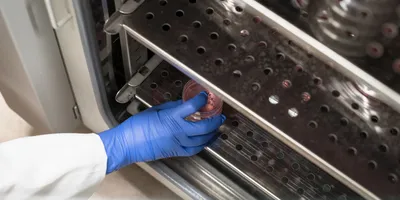The importance of metabolic monitoring
Glucose is the primary metabolic fuel for cells; consequently, monitoring its consumption and ensuring an adequate supply are essential for maintaining ideal conditions in cell cultures, thereby promoting optimal growth. Through glycolysis—a fundamental metabolic process—cells extract energy from glucose, producing pyruvate as an intermediate, which, in the absence of oxygen, is then further reduced to the byproduct lactate.2
Monitoring glucose and lactate levels not only reveals the functionality of the glycolysis pathway but also provides a detailed understanding of the cells' physiological state and the overall health of the culture. As cultures become more complex there is an increased need to accurately measure and monitor cell metabolism to determine how this affects function and longevity.
The pitfalls of traditional approaches to metabolic monitoring
Measuring cell metabolism is an essential part of cell culture but traditional, manual approaches are labor-intensive. Typically, the culture must be retrieved from the incubator, moved to a biosafety cabinet , prepared to perform an end-point assay, , and finally, the data must be analyzed and interpreted. Although, automated approaches have streamlined some of these manual steps, the fundamental issue remains the same: samples must still be taken from the cell culture and measured offline.
This approach presents several challenges:
- Cell contamination risks: Removing the cells from their normal environment may negatively impact growth. Also, each time the cells are removed from their incubation environment, there is a risk of contamination which could halt the experiment entirely—a particularly costly outcome when working with rare cell types.3
- Sampling and loss of valuable cellular material: Traditional monitoring methods often require adding reagents or markers to the cells, rendering them unusable for further culture. This irreversible nature of sampling leads to a progressive loss of experimental material with each measurement. For researchers working with rare, valuable, or limited cell populations—such as patient-derived samples or difficult-to-obtain primary cells—this continuous depletion of cellular material is particularly problematic and can hamper experimental progress.4
- Logistical complexities: Manual sampling necessitates staff presence in the laboratory, even at inconvenient times such as late nights or weekends. This requirement can strain resources, complicate research schedules, and potentially necessitate additional lab staff to ensure sufficient cover during the entirety of the week.
- Data gaps: Perhaps most crucially, manual, periodic metabolic monitoring leaves researchers “blindfolded” during long intervals between measurements—often up to 12 hours. These gaps could obscure subtle changes in culture health, meaning that researchers might miss critical opportunities to optimize culture conditions. Moreover, in drug studies, these data gaps might conceal key moments of cellular response; a drug’s peak efficacy or the onset of off-target effects, impacting the interpretation of results and the direction of research.
Attempts to mitigate these issues by increasing sampling frequency only exacerbate workload and resource demands, creating a challenging trade-off between data resolution and operational efficiency, underscoring the need for more efficient, continuous monitoring solutions.3,4
A new alternative: continuous in-line monitoring technologies
Novel alternatives have emerged that address the pitfalls of traditional monitoring methods, by offering continuous, in-line monitoring of cell culture glycolysis within CO2 incubators.
These technologies fit standard, commercial 24-well plates with high precision sensors placed directly in the cell culture medium. A detector unit—easily fitted in a CO2 incubator—houses the sensor and provides real-time readouts of glucose and lactate levels. While these systems offer new capabilities, they are underpinned by well-established technologies. So far, continuous metabolic monitoring systems have been used in multi-day experiments into T-cell differentiation1 and have been trialed in numerous areas of study including 3D organoid work, stem cell differentiation and drug assaying in tumor derived cell lines. This demonstrates their potential in a broad range of research applications.
A fuller picture of cell metabolism
By eliminating data gaps inherent in manual methods, in-line monitoring systems offer enhanced insights into cellular metabolism and overall culture health. This continuous stream of data—collected at one-minute intervals—proves particularly valuable in advanced therapy development. For example:
- CAR-T manufacturing: Each stage of CAR-T production has unique metabolic requirements, with even minor fluctuations impacting efficacy and side effects. 5 Continuous metabolic monitoring could therefore serve as a powerful tool for optimizing the manufacture of CAR-T cells.
- Mesenchymal stromal cells (MSCs): As interest grows in manipulating MSC metabolism to control cell survival, retention, and differentiation,6 real-time metabolic data could become key for developing our understanding.
- Drug resistance studies: In advanced cell therapy research, in-line monitoring systems could aid study into the role of altered cell metabolism on drug resistance. For instance, recent studies on methotrexate-resistant cancer cells have revealed metabolic shifts.7 Real-time glycolysis analysis could be valuable in elucidating further insights into the metabolic changes within these cells.
Reduced contamination risk
As the system sits within the incubator and takes continuous measurements, there is less need to handle the cultures, reducing the risk of contamination and damage to the cells.
Preservation of valuable cell samples
In-line monitoring allows for the preservation of cells for further evaluation. This is particularly crucial when working with rare, valuable, or limited cell populations, as it does not sacrifice cellular material for measurements.
Reduced logistical complexity
Continuous sampling negates the need to plan for sampling at inconvenient times, reducing resource requirements on weekends or at night, and in turn, simplifying research schedules and lessening strain on laboratory staff. What’s more, as laboratory staff no longer have to conduct laborious manual processes associated with traditional monitoring methods, they can dedicate more time to high-value tasks that help drive research forward.
Advanced Lab Management Certificate
The Advanced Lab Management certificate is more than training—it’s a professional advantage.
Gain critical skills and IACET-approved CEUs that make a measurable difference.
Improved cost efficiency
In-line monitoring technologies could offer cost savings by allowing non-destructive measurement of cell cultures. This capability is especially valuable for expensive cell lines and samples, as it preserves the entire population for continued growth and experimentation. By preventing the depletion of valuable cell material and minimizing the risk of contamination, in-line monitoring ensures more efficient use of resources, making it particularly beneficial in long-term or large-scale research projects.
Case study: Continuous, in-line metabolic monitoring at the Centre for Commercialization of Regenerative Medicine (CCRM)
CCRM, a leader in developing and commercializing regenerative medicine-based technologies and cell and gene therapies, has recently beta tested and implemented continuous in-line metabolic monitoring of their cell cultures to enhance process development. In cell and gene therapy manufacturing, monitoring multiple parameters throughout the production process is crucial, as variations in conditions can affect the quality, efficacy, and safety of the final product.
CCRM recently implemented a continuous in-line metabolic monitoring system in a scale-down model of their platform processes. The results were comparable to their previous manual periodic sampling method, but with key advantages:
- The system gathered substantially more data
- Data collection occurred in real-time
- Labor requirements for cell culture monitoring were greatly reduced
This technology will ultimately allow CCRM to refine and more tightly control its processes.
While using a live metabolic monitoring system was successful in a scaled-down version of their process, the current 24-well formats available were too small for full integration into CCRM’s standard operations. As a result, experiments had to be conducted in parallel with existing processes, rather than as part of them.
Looking to the future, CCRM hopes this issue will be overcome and sees great potential in combining these monitoring technologies with automation, AI, and machine learning. CCRM anticipates that this integration will further enhance its ability to optimize processes and potentially reduce production costs while maintaining product quality.
The future of cell culture metabolic analysis
Understanding cell metabolism is crucial for optimizing cell cultures and advancing therapeutic research. While conventional monitoring methods have long posed challenges such as contamination risks and data gaps, continuous in-line monitoring technologies are helping revolutionize the field. These systems provide real-time, non-destructive measurements of key metabolic indicators, preserving valuable cell populations and offering unprecedented insights into cellular behavior.
The impact of this technology extends across various research areas, from enhancing CAR-T cell manufacturing to unraveling the complexities of drug resistance in cancer therapy. As these monitoring systems evolve, their integration with automation, AI, and machine learning promises to unlock even deeper insights into cell metabolism.
Ultimately, continuous metabolic monitoring is set to become an indispensable tool in cell culture research, driving the development of more effective and cost-efficient advanced therapies that could transform patient care.
References:
- Yamamoto W, Hamada T, Suzuki J, et al. Suppressive effect of the anesthetic propofol on T cell function and T cell-dependent immune responses. Sci Rep. 2024;14:19337. doi:10.1038/s41598-024-19337-5. Available at: https://www.nature.com/articles/s41598-024-69987-z
- DeBerardinis RJ, Chandel NS. Fundamentals of cancer metabolism. Sci Adv. 2016;2(5) doi:10.1126/sciadv.1600200. Available at: https://www.ncbi.nlm.nih.gov/pmc/articles/PMC4276425/
- Pamies D, Leist M, Coecke S, et al. Guidance document on Good Cell and Tissue Culture Practice 2.0 (GCCP 2.0). ALTEX. 2022;39:30-70. doi:10.14573/altex.2111011. Available at: https://www.altex.org/index.php/altex/article/view/2376/2327
- Braissant O, Astasov-Frauenhoffer M, Waltimo T, Bonkat G. A review of methods to determine viability, vitality, and metabolic rates in microbiology. Front Microbiol. 2020;11:547458. doi:10.3389/fmicb.2020.547458. Available at: https://www.ncbi.nlm.nih.gov/pmc/articles/PMC7705206/
- Zhang, M., Jin, X., Sun, R. et al. Optimization of metabolism to improve efficacy during CAR-T cell manufacturing. J Transl Med19, 499 (2021). https://doi.org/10.1186/s12967-021-03165-xAvailable at: https://translational-medicine.biomedcentral.com/articles/10.1186/s12967-021-03165-x
- Sigmarsdóttir Þ, McGarrity S, Rolfsson Ó, et al. Current status and future prospects of genome-scale metabolic modeling to optimize the use of mesenchymal stem cells in regenerative medicine. Front Bioeng Biotechnol. 2020;8:239. doi:10.3389/fbioe.2020.00239.Available at: https://www.frontiersin.org/journals/bioengineering-and-biotechnology/articles/10.3389/fbioe.2020.00239/full
- Takashima Y, Hayano A, Yamanaka R. Metabolome analysis reveals excessive glycolysis via PI3K/AKT/mTOR and RAS/MAPK signaling in methotrexate-resistant primary CNS lymphoma-derived cells. Clin Cancer Res. 2020;26(11):2754-2766. doi:10.1158/1078-0432.CCR-18-3851.Available at: https://pubmed.ncbi.nlm.nih.gov/32108030/











